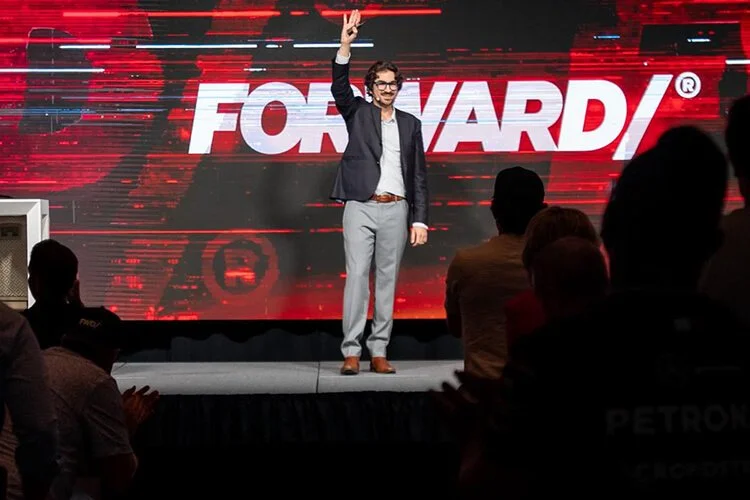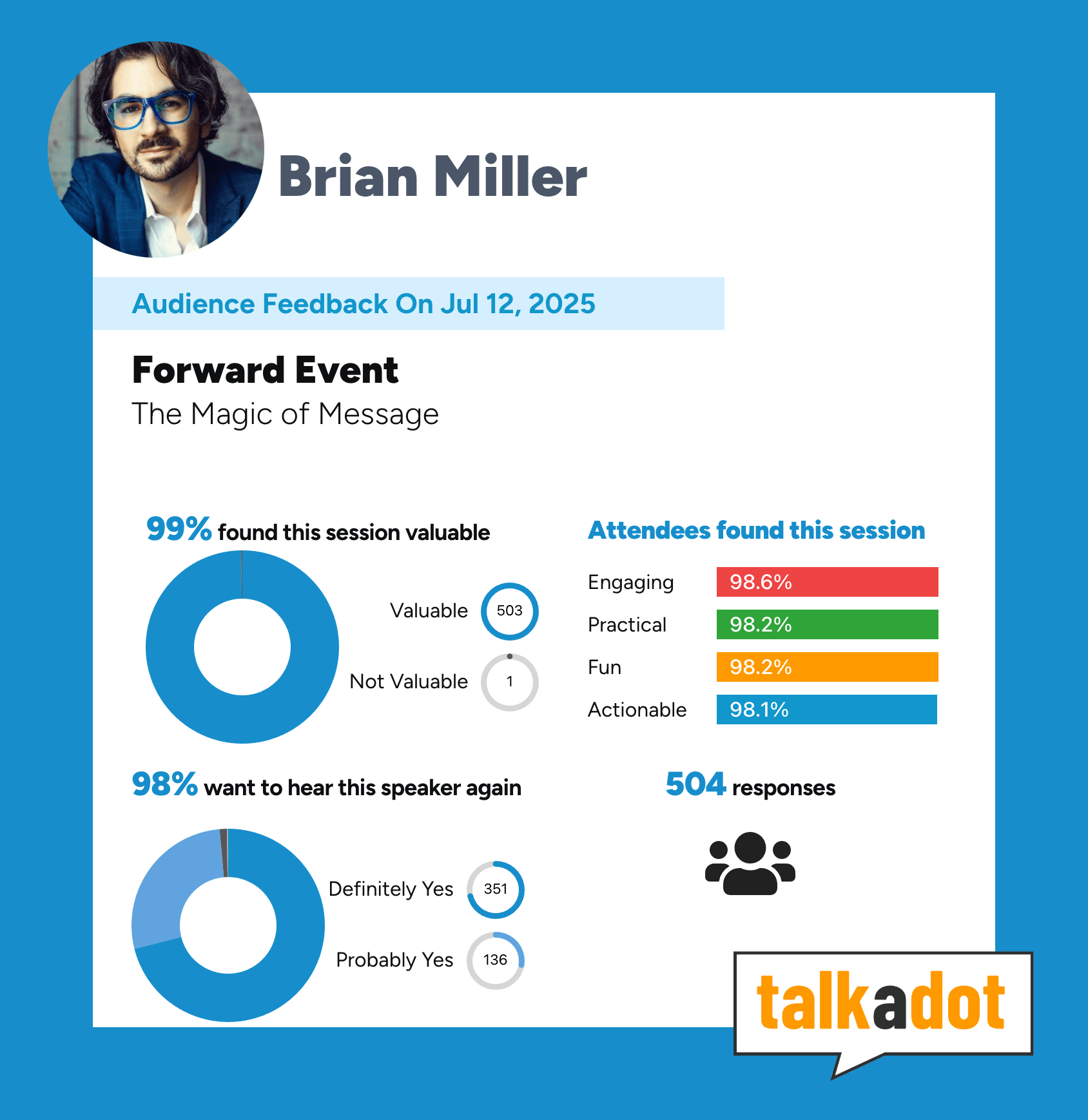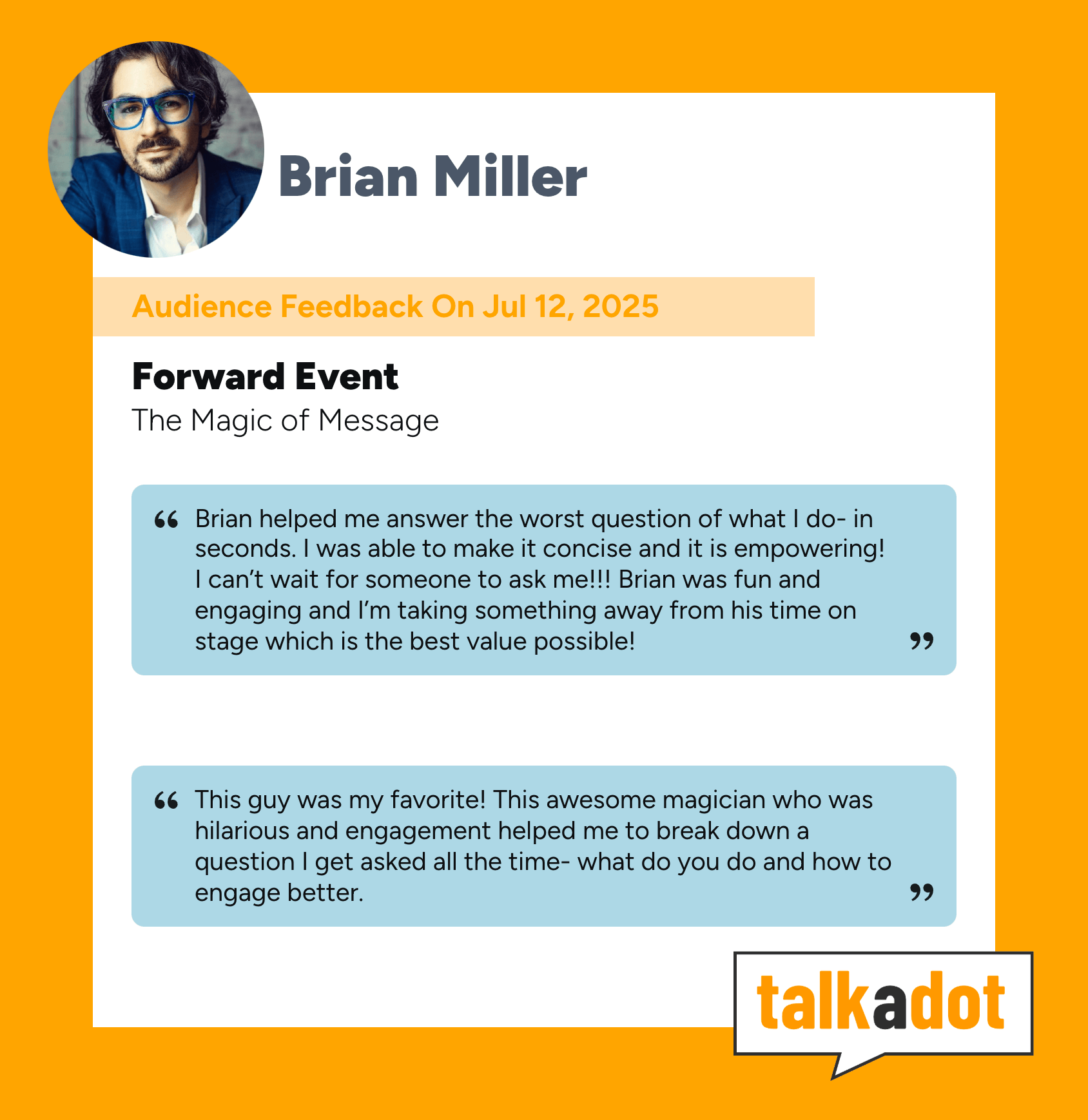It’s the Speech, Not the Speaker: Why some talks live on (and others fade fast)
"Hi! I'm listening to one of my regular podcasts, and they were raving about your presentation in Vegas!"
That's the DM I received from my cousin, about two weeks after stepping off-stage.
Now, being totally honest, I was a little nervous going into this event.
Forward's roster is stacked with celebrities and major influencers. The kind of people I look up to and study. It wasn't the typical corporate meeting where, let's be real, it's not that hard to stand out.
This is The Super Bowl. Woodstock. The Olympics.
So after thanking my cousin, I clicked on the episode and started listening. I was thrilled to be mentioned at all, and hoping that they discussed something other than the magic tricks I did.
What I actually heard put a big smile on my face.
Out of twelve speakers on the main stage, the hosts of this podcast only discussed four in their recap. And of those four, my keynote took up 4 minutes and 15 seconds of their conversation. Which worked out to 3x longer than the next most-discussed speaker, and 7x longer than the least.
Not because I was the biggest name, the funniest, the most credentialed, or the highest-energy (I was none of those). Not even because I was the ‘best’ - that’s relative, and I claim no such thing.
My talk out-performed the post-talk discussion simply because that’s what the talk was designed to do.
It’s not incidental. It's intentional.
What Did They Discuss?
The podcast hosts didn’t say, “Brian was great.” Instead they quoted my core message, retold my opening story, and role-played the framework I had taught, applying it to their own work on the spot.
Most importantly, not every second they spent was about me. They referenced other thought leaders’ work, compared notes from past events, and branched off into their own examples. But all of those tangents still anchored back to my talk.
If you’re in the business of spreading ideas, this is exactly what you want to hear.
As someone who has spent the last decade helping leaders and experts craft speeches that drive action, I know exactly why this happened, and how you can replicate that in your own speeches.
The Core Insight: It’s Not the Speaker, It’s the Speech
We tend to give credit to the person on stage.
“They’re such a natural speaker.”
“They’ve got great stage presence.”
“They’re just charismatic.”
But charisma only gets you remembered in the moment. What lives on — what gets quoted, retold, and applied weeks later — is the speech itself.
My keynote is engineered for one thing: spreadability. And that comes down not to delivery, but design.
What Makes a Talk Stick Weeks Later
When I broke down the podcast transcript, three elements jumped out. These are the same elements I teach in my new book on keynote design for untrained speakers, because they’re the difference between applause in the room and action afterward.
1. They Could Remember the Core Message
Weeks after the event, they could paraphrase my core message from memory:
“It’s not the best magician who wins. It’s the one who packages their value clearly.”
A clear, concise core message acts like a mental bookmark. It gives the audience something to hang the rest of your talk on, so when they tell someone about it later, they can say:
“I heard a talk about X,” and actually fill in the “X” with something meaningful.
How to do this in your own talk:
Boil it down. If your audience can’t summarize your message in one sentence, you’re making them work too hard.
Make it concrete. Avoid vague abstractions. Tie your big idea to something specific and visual.
Aim for universality. Your core message should feel true beyond your own niche.
2. They Could Retell the Story Hook
When the host asked, “Who was the magician guy?” they were able to recount my story about starting as a magician, realizing technical skill wasn’t enough, and learning to package my value in a way that connected with buyers.
They didn’t get every detail right (no one ever does), but they told enough of it to give context to a new listener who hadn’t been there. That’s the sign of a strong story hook. It’s short, vivid, and easy to pass along without losing the point.
And here’s the key: my magician story isn’t really about magic. It’s a vehicle for a universal truth their listeners could relate to in their own businesses.
How to do this in your own talk:
Choose stories that carry your point. Don’t tell a story just because it’s interesting, tragic, or epic. Tell it because it proves your message.
Design for re-telling. Keep the sequence simple: context → change → result (CCR).
Cut details that don’t serve recall. If they’re not essential to the point, they’re clutter.
3. They Had a Framework to Apply
The real magic happened when they started role-playing the “I help [audience] to [action] so that [impact]” formula I taught for answering “What do you do?”
This wasn’t just a concept they could nod along to. It was a tool they could use instantly, on air and in realtime, to reframe their own messaging.
That’s the difference between a speech that inspires and one that equips. A framework gives people a way to do something with your idea, not just think about it.
How to do this in your own talk:
Teach something portable. If it requires your entire slide deck to explain, it won’t live past the event.
Make it fill-in-the-blank. People remember what they’ve customized for themselves.
Demonstrate in the room. Let them try it right there so they know it works.
Why These Three Elements Matter
When you give your audience:
A core message they can remember,
A story hook they can retell,
A framework they can apply,
…you give them everything they need to carry your talk into new rooms without you.
That’s why my Forward segment lived on in that podcast conversation: because the talk was designed to be remembered, retold, and reused.
Reminder: It's Not About the Tricks
"But Brian, it's so easy for you to be memorable. You do magic tricks."
Yes, during my keynote at Forward, I did perform magic. Nearly 8 minutes of it across my 45-min keynote. But in that podcast conversation weeks later? They didn’t mention a single trick I did. Not once.
Because the magic wasn’t the point. The stories, the message, and the framework were what they carried with them. That’s exactly why I believe design beats delivery.
Jump-kicks, magic tricks, props, and punchlines can capture attention in the moment, but if you want your talk to live on, it needs a core message they can remember, a story they can retell, and a framework they can apply.
The Real Measure of a Great Talk
Standing ovations are nice. Post-event selfies are fun. But the true test is this:
What happens when you’re no longer in the room?
In the world of keynote speaking, the buzz is the business.
If your talk lives on in team meetings, in coffee shop conversations, in podcast recaps- you’ve done your job. If it’s gone the moment the lights dim, you haven’t (no matter how many people lined up to shake your hand).
And to be clear, this isn’t about comparing myself to the other speakers at Forward. They were all terrific, and many of them were there to serve a different role entirely.
Some speakers are hired to amp up the audience. To bring energy, excitement, and motivation in the moment. That’s a different kind of talk, and it’s just as valuable. Those talks might not be designed to be retold in a podcast a week later, but they’re essential for setting the emotional tone of the event.
Others are there to share a breakthrough case study, to inspire through personal story, or to teach a specific technical skill. Others were there to, let's be honest, sell tickets by putting their face on the poster. Every slot on the program exists for a reason.
My role in that mix was to deliver an actionable talk. Something attendees could take home and use. That’s why it stuck the way it did.
And my guess is that’s the kind of talk you want to give.
Designing for Buzz
If you want your next keynote to have the same staying power, start by asking yourself:
Core Message: Can they say it back to me in one sentence?
Story Hook: Could they retell it at a dinner party and get the point across?
Framework: Can they apply it right now without me in the room?
If the answer to any of these is “no,” go back to the design. And if you need help building a keynote speech from scratch, jump on the waitlist for my new book The One-Page Keynote™: How Untrained Speakers Can Command Any Room, On Any Topic, for 20 Minutes or More.
Thanks for reading and your support of the new book!
~Brian
P.S. It's not just one podcast that proves my thesis. Here's the attendee feedback:













If someone Googled you right now, would they meet the version of you that actually exists?
That’s the question that opened our recent masterclass on brand voice - and it landed hard.
Avital Eusgeld - founder of HiPitched Branding and the strategist behind some of the clearest, most human brand voice systems out there - says most of us are showing up online with a mix of “sort of me,” “past me,” and “this was a Canva template.”